A Pro's Guide to Cooking with Greens
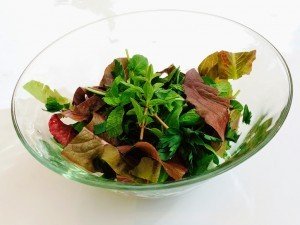 What do you know about cooking with greens?Getting the best flavor and texture out of fresh greens is a passion of mine, and I've learned quite a few tricks over my years in the kitchen. The best part is, today is the day that I share those tricks with you! After that, you in turn can pass these ideas along to your clients, who will be cooking with greens like pros in no time.You see, it all comes down to pairing the right greens with the right flavors and textures in order to make them shine. Plus, knowing what nutrients and health benefits each green offers can help motivate your clients to try cooking with these greens in the first place. Let's take an in-depth look at each green, then celebrate with a free infographic that you can send to your clients.Meet Your Green: Spinach
What do you know about cooking with greens?Getting the best flavor and texture out of fresh greens is a passion of mine, and I've learned quite a few tricks over my years in the kitchen. The best part is, today is the day that I share those tricks with you! After that, you in turn can pass these ideas along to your clients, who will be cooking with greens like pros in no time.You see, it all comes down to pairing the right greens with the right flavors and textures in order to make them shine. Plus, knowing what nutrients and health benefits each green offers can help motivate your clients to try cooking with these greens in the first place. Let's take an in-depth look at each green, then celebrate with a free infographic that you can send to your clients.Meet Your Green: Spinach Flavor Profile: A mild and delicate green, spinach is slightly bitter and slightly sweet.Nutrient Profile: 1 cup of raw spinach contains...
Flavor Profile: A mild and delicate green, spinach is slightly bitter and slightly sweet.Nutrient Profile: 1 cup of raw spinach contains...
- 7 calories
- 1 g fiber
- 56% DV vitamin A
- 14% DV vitamin C
- 181% DV vitamin K
- 3% DV calcium
- 15% DV folate
- 5% DV iron
Vitamin K is a fat-soluble vitamin that plays a key role in proper blood clotting. It may help strengthen bones as well.Cook It? Yes! Spinach is delicious raw or cooked.Preparation Inspiration: Try it raw in salads with fresh fruit, or cook it with a little broth for a quick side dish. Serve it with a little heart-healthy fat (think avocado, olive oil, or fish) in order to reap the most health benefits.Meet Your Green: Kale Flavor Profile: Bitter and earthy, kale's flavor mellows a bit when cooked.Nutrient Profile: 1 cup of raw kale contains...
Flavor Profile: Bitter and earthy, kale's flavor mellows a bit when cooked.Nutrient Profile: 1 cup of raw kale contains...
- 33 calories
- 1 g fiber
- 206% DV vitamin A
- 9% DV vitamin B6
- 134% DV vitamin C
- 9% DV calcium
- 6% DV iron
Vitamin A helps your body form and maintain healthy bones and teeth, while also strengthening mucus membranes and your skin.Cook It? Yes! Though you can also eat it raw, most people find kale more palatable when cooked.Preparation Inspiration: Saute kale in a little garlic and olive oil until tender if you would like to create a fantastic bed for lean protein like chicken breast or tofu. You can also toss a handful of kale into a blender with some fruit and unsweetened tea for a healthful green smoothie.Bonus: For more information about kale, check out the post Kale 101: Everything You Need to Know.Meet Your Green: Collard Greens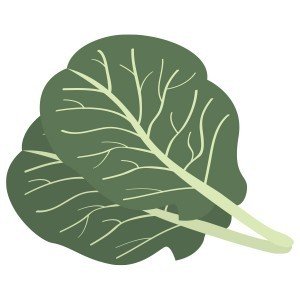 Flavor Profile: Collard greens taste grassy and a bit harsh, with earthy undertones.Nutrient Profile: 1 cup of raw collard greens contains...
Flavor Profile: Collard greens taste grassy and a bit harsh, with earthy undertones.Nutrient Profile: 1 cup of raw collard greens contains...
- 11 calories
- 1 g fiber
- 1 g protein
- 48% DV vitamin A
- 21% DV vitamin C
- 230% DV vitamin K
- 5% DV calcium
- 15% DV folate
- 5% DV manganese
Vitamin C strengthens the immune system and helps the body absorb iron.Cook It? Yes. Collards benefit from long cooking over low heat. They are not very tasty when raw.Preparation Inspiration: Braise collard greens over low heat with chopped onion and broth for a tasty and versatile side dish. Toss cooked greens with your favorite spices to vary the flavor profile.Meet Your Green: Lettuce Flavor Profile: Lettuce tastes cool and fresh, with a hearty crunch.Nutrient Profile: 1 cup of raw Romaine lettuce contains...
Flavor Profile: Lettuce tastes cool and fresh, with a hearty crunch.Nutrient Profile: 1 cup of raw Romaine lettuce contains...
- 8 calories
- 1 g fiber
- 1 g protein
- 82% DV vitamin A
- 19% DV vitamin C
- 2% DV calcium
- 3% DV iron
- 16% DV folate
- 3% DV potassium
Folate works with vitamin B12 to help form red blood cells and is vital to the production of DNA.Cook It? No. Lettuce is generally best served raw, adding crunch and heart to fresh salads.Preparation Inspiration: Toss chopped dark green lettuce with a bit of flavored vinegar and nuts for a healthful side salad, or add some grilled chicken or fish to lend some staying power to the meal, turning your side salad into a main dish.Bonus: For more salad inspiration, check out the post 12 Salad Presentations.Meet Your Green: Mustard Greens Flavor Profile: Sharp and peppery, mustard greens taste quite a lot like mustard.Nutrient Profile: 1 cup of raw mustard greens contains...
Flavor Profile: Sharp and peppery, mustard greens taste quite a lot like mustard.Nutrient Profile: 1 cup of raw mustard greens contains...
- 15 calories
- 2 g fiber
- 2 g protein
- 118% DV vitamin A
- 65% DV vitamin C
- 6% DV vitamin E
- 6% DV calcium
- 5% DV iron
- 26% DV folate
- 13% DV manganese
Manganese is a key component in many different enzymes.Mustard greens have more protein per cup than other greens as well.Cook It? Yes. Mustard greens are super tasty raw or cooked.Preparation Inspiration: The spicy sharpness of mustard greens make them the perfect counterpart to smooth or rich-tasting dishes. Sauté them with a little broth and top with walnuts for a tasty side, or throw a few handfuls into your next salad.Whew! That was a lot of detail about 5 great greens. Are you still with me?Good, because my team has created a wonderful infographic that's all about greens. Get your copy now and share it with your clients today.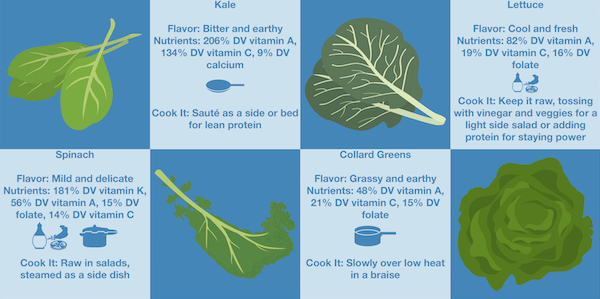 And speaking of exciting nutrition education resources, have you seen the latest to hit the Nutrition Education Store? Here are some fun new materials...
And speaking of exciting nutrition education resources, have you seen the latest to hit the Nutrition Education Store? Here are some fun new materials...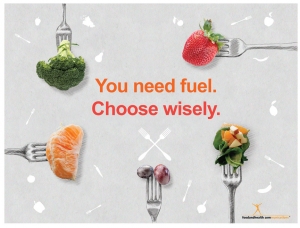

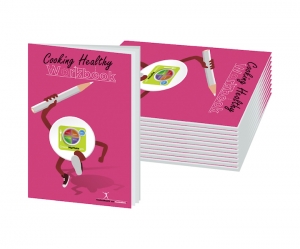 Plus, I'd like to take a moment to shine a spotlight on all the new nutrition handouts that are now available for you. These handouts are colorful, engaging, and informative. They employ strategies that make them appealing for a variety of learning styles, promoting maximum information retention right when you need it the most. Take a look and see the goodness for yourself!
Plus, I'd like to take a moment to shine a spotlight on all the new nutrition handouts that are now available for you. These handouts are colorful, engaging, and informative. They employ strategies that make them appealing for a variety of learning styles, promoting maximum information retention right when you need it the most. Take a look and see the goodness for yourself!


